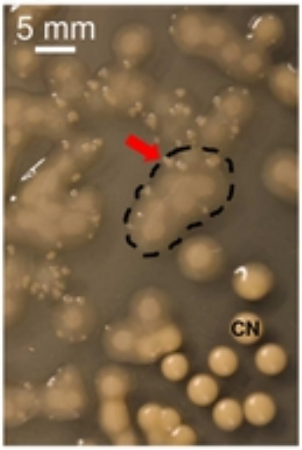Amoeba predation of Cryptococcus neoformans results in pleiotropic changes to traits associated with virulence
Preprint posted on 7 August 2020 https://www.biorxiv.org/content/10.1101/2020.08.07.241190v1
Article now published in mBio at http://dx.doi.org/10.1128/mbio.00567-21
Survival in soil promotes human infection: The evolution of cryptococcal virulence
Selected by Josie GibsonCategories: microbiology
Background:
Cryptococcus neoformans is an environmental fungus, which is also an opportunistic human fungal pathogen. As such, C. neoformans infection can cause life-threatening disease, usually in immunocompromised individuals. To cause infection, C. neoformans has evolved multiple virulence factors, allowing survival within the host. Of particular importance is the ability for cryptococci to survive within, and then escape from, macrophages. However, C. neoformans is an environmental yeast, which does not require human infection as part of its life-cycle, raising the question how C. neoformans evolved virulence factors to survive within macrophages. It has previously been demonstrated that exposure to amoebae, which are soil resident predators sharing similar properties to macrophages, increases cryptococcal virulence [1]. In this study, the selective pressure of exposure to amoebae is studied to examine the mechanisms of how amoebae-cryptoccocal interactions alter cryptoccocal virulence factor selection.
Key findings:
This study shows that exposure of amoebae to C. neoformans leads to increased diversity in cryptococcal traits and virulence factors. This may enable continued environmental survival, since increased diversity may provide a higher chance of some cryptococcal survival. Virulence factor selection driven by amoebae predation may also be a cause of improved human infection, specifically in macrophage resistance.
Using lab and environmental cryptococcal strains, cryptococcal cells were left in the presence of amoebae for a month, after which, cryptococcal colonies had formed that were composed of multiple morphologies. In general, the surviving cryptococcal cells were more resistant to amoebae predation, however, environmental strains were less likely than the lab strain to gain resistance. Pseudohyphae or large cell volume phenotypes formed in resistant strains, which the authors suggest to be important for amoeba resistance. Moreover, known human virulence factors were commonly present in the resistant cryptococcal strains.

Next, the authors show DNA mutations can occur in cryptococcal isolates following predation, altering roles in quorum sensing, hyphae formation and stress responses. Interestingly, some resistant cryptococci did not have mutations, suggesting an alternative cause of resistance phenotypes than mutations alone. A small number of resistant strains had a chromosome duplication, with roles in increased amoebae resistance. Interestingly, epigenetic modifications were not associated with amoeba resistance.
Finally, the impact of the virulence factors obtained by amoebae resistant cryptococcal strains was examined using macrophages and in vivo infection. Unexpectedly, none of the resistant strains had improved intracellular survival in macrophages, although some isolates caused physical damage to macrophages. Furthermore, the isolates which did cause macrophage damage, did not have increased virulence in murine infection. The authors determined the lack of murine virulence was due to induction of a more effective immune response.
Why I chose this Preprint:
The authors examine mechanisms of cryptoccocal environmental evolution which may promote macrophage evasion in human infection. The study demonstrates that amoebae pressure drives rapid selection of diverse cryptococcal virulence factors (many which are associated with human infection), and determines some are caused by DNA mutations and aneuploidy. This study furthers our understanding of how environmental evolution of C. neoformans may lead to the ability of an environmental fungus to survive within macrophages and cause human disease. Furthermore, the authors suggest that mechanisms driving diversity of virulence factors studied here, may represent an alternative antimicrobial target.
Questions to the authors:
- Could differences in soil predators in different locations worldwide be important in outbreaks of cryptoccocal infections?
- Considering that epigenetic modifications could lead to rapid cryptococcal adaptation, do you have any suggestions why it is not involved in amoeba resistance?
- There was no increase in macrophage persistence or in vivo infection virulence in resistant strains. Do you think that using longer predation times with increased variety of amoebae predators could increase the likelihood of finding a virulent strain?
References:
- Chrisman CJ, Albuquerque P, Guimaraes AJ, Nieves E, Casadevall A (2011) Phospholipids Trigger Cryptococcus neoformansCapsular Enlargement during Interactions with Amoebae and Macrophages. PLoS Pathog 7(5): e1002047. https://doi.org/10.1371/journal.ppat.1002047
Posted on: 2 September 2020 , updated on: 25 March 2021
doi: https://doi.org/10.1242/prelights.24364
Read preprintSign up to customise the site to your preferences and to receive alerts
Register hereAlso in the microbiology category:
RIPK3 coordinates RHIM domain-dependent inflammatory transcription in neurons
Digital Microbe: A Genome-Informed Data Integration Framework for Collaborative Research on Emerging Model Organisms
Mixed Alkyl/Aryl Phosphonates Identify Metabolic Serine Hydrolases as Antimalarial Targets
preLists in the microbiology category:
BioMalPar XVI: Biology and Pathology of the Malaria Parasite
[under construction] Preprints presented at the (fully virtual) EMBL BioMalPar XVI, 17-18 May 2020 #emblmalaria
| List by | Dey Lab, Samantha Seah |
1
ECFG15 – Fungal biology
Preprints presented at 15th European Conference on Fungal Genetics 17-20 February 2020 Rome
| List by | Hiral Shah |
EMBL Seeing is Believing – Imaging the Molecular Processes of Life
Preprints discussed at the 2019 edition of Seeing is Believing, at EMBL Heidelberg from the 9th-12th October 2019
| List by | Dey Lab |
Antimicrobials: Discovery, clinical use, and development of resistance
Preprints that describe the discovery of new antimicrobials and any improvements made regarding their clinical use. Includes preprints that detail the factors affecting antimicrobial selection and the development of antimicrobial resistance.
| List by | Zhang-He Goh |











 (No Ratings Yet)
(No Ratings Yet)